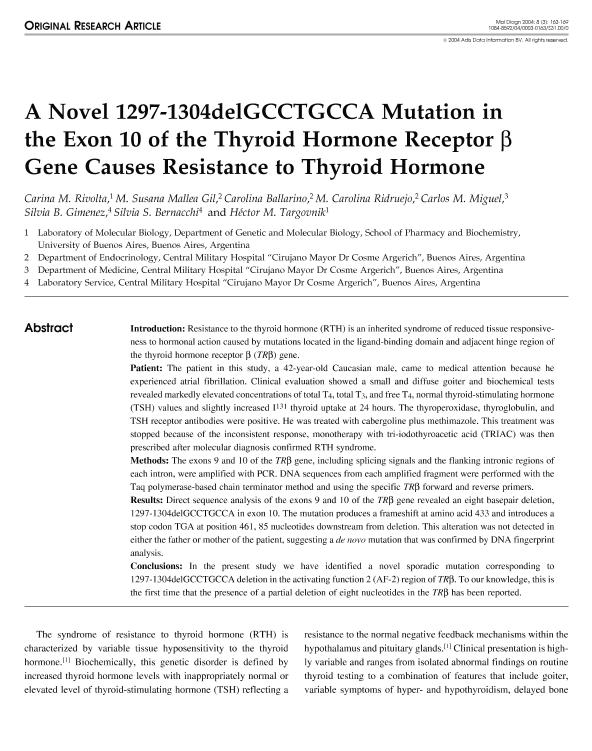Mostrar el registro sencillo del ítem
dc.contributor.author
Rivolta, Carina Marcela

dc.contributor.author
Mallea Gil, M. Susana
dc.contributor.author
Ballarino, Carolina
dc.contributor.author
Ridruejo, M. Carolina
dc.contributor.author
Miguel, Carlos M.
dc.contributor.author
Gimenez, Silvia B.
dc.contributor.author
Bernacchi, Silvia S.
dc.contributor.author
Targovnik, Hector Manuel

dc.date.available
2020-11-24T15:23:48Z
dc.date.issued
2012-12-01
dc.identifier.citation
Rivolta, Carina Marcela; Mallea Gil, M. Susana; Ballarino, Carolina; Ridruejo, M. Carolina; Miguel, Carlos M.; et al.; A novel 1297–1304delGCCTGCCA mutation in the exon 10 of the thyroid hormone receptor β gene causes resistance to thyroid hormone; Springer; Molecular Diagnosis & Therapy; 8; 3; 1-12-2012; 163-169
dc.identifier.issn
1177-1062
dc.identifier.uri
http://hdl.handle.net/11336/118865
dc.description.abstract
Introduction: Resistance to the thyroid hormone (RTH) is an inherited syndrome of reduced tissue responsiveness to hormonal action caused by mutations located in the ligand-binding domain and adjacent hinge region of the thyroid hormone receptor β (TRβ) gene. Patient: The patient in this study, a 42-year-old Caucasian male, came to medical attention because he experienced atrial fibrillation. Clinical evaluation showed a small and diffuse goiter and biochemical tests revealed markedly elevated concentrations of total T4, total T3, and free T4, normal thyroid-stimulating hormone (TSH) values and slightly increased I131 thyroid uptake at 24 hours. The thyroperoxidase, thyroglobulin, and TSH receptor antibodies were positive. He was treated with cabergoline plus methimazole. This treatment was stopped because of the inconsistent response, monotherapy with tri-iodothyroacetic acid (TRIAC) was then prescribed after molecular diagnosis confirmed RTH syndrome. Methods: The exons 9 and 10 of the TRβ gene, including splicing signals and the flanking intronic regions of each intron, were amplified with PCR. DNA sequences from each amplified fragment were performed with the Taq polymerase-based chain terminator method and using the specific TRβ forward and reverse primers. Results: Direct sequence analysis of the exons 9 and 10 of the TRβ gene revealed an eight basepair deletion, 1297-1304delGCCTGCCA in exon 10. The mutation produces a frameshift at amino acid 433 and introduces a stop codon TGA at position 461, 85 nucleotides downstream from deletion. This alteration was not detected in either the father or mother of the patient, suggesting a de novo mutation that was confirmed by DNA fingerprint analysis. Conclusions: In the present study we have identified a novel sporadic mutation corresponding to 1297-1304delGCCTGCCA deletion in the activating function 2 (AF-2) region of TRβ. To our knowledge, this is the first time that the presence of a partial deletion of eight nucleotides in the TRβ has been reported.
dc.format
application/pdf
dc.language.iso
eng
dc.publisher
Springer

dc.rights
info:eu-repo/semantics/openAccess
dc.rights.uri
https://creativecommons.org/licenses/by-nc-sa/2.5/ar/
dc.subject
Atrial Fibrillation
dc.subject
Thyroid Hormone
dc.subject
Cabergoline
dc.subject
Thyroid Hormone Receptor
dc.subject
Thyroid Hormone Level
dc.subject.classification
Genética Humana

dc.subject.classification
Medicina Básica

dc.subject.classification
CIENCIAS MÉDICAS Y DE LA SALUD

dc.title
A novel 1297–1304delGCCTGCCA mutation in the exon 10 of the thyroid hormone receptor β gene causes resistance to thyroid hormone
dc.type
info:eu-repo/semantics/article
dc.type
info:ar-repo/semantics/artículo
dc.type
info:eu-repo/semantics/publishedVersion
dc.date.updated
2020-11-03T15:20:44Z
dc.identifier.eissn
1179-2000
dc.journal.volume
8
dc.journal.number
3
dc.journal.pagination
163-169
dc.journal.pais
Suiza

dc.journal.ciudad
Basel
dc.description.fil
Fil: Rivolta, Carina Marcela. Universidad de Buenos Aires. Facultad de Farmacia y Bioquímica. Departamento de Microbiología, Inmunología y Biotecnología. Cátedra de Genética y Biología Molecular; Argentina. Consejo Nacional de Investigaciones Científicas y Técnicas. Oficina de Coordinación Administrativa Houssay. Instituto de Inmunología, Genética y Metabolismo. Universidad de Buenos Aires. Facultad de Medicina. Instituto de Inmunología, Genética y Metabolismo; Argentina
dc.description.fil
Fil: Mallea Gil, M. Susana. Ministerio de Defensa. Ejército Argentino. Hospital Militar Central Cirujano Mayor "Dr. Cosme Argerich"; Argentina
dc.description.fil
Fil: Ballarino, Carolina. Ministerio de Defensa. Ejército Argentino. Hospital Militar Central Cirujano Mayor "Dr. Cosme Argerich"; Argentina
dc.description.fil
Fil: Ridruejo, M. Carolina. Ministerio de Defensa. Ejército Argentino. Hospital Militar Central Cirujano Mayor "Dr. Cosme Argerich"; Argentina
dc.description.fil
Fil: Miguel, Carlos M.. Ministerio de Defensa. Ejército Argentino. Hospital Militar Central Cirujano Mayor "Dr. Cosme Argerich"; Argentina
dc.description.fil
Fil: Gimenez, Silvia B.. Ministerio de Defensa. Ejército Argentino. Hospital Militar Central Cirujano Mayor "Dr. Cosme Argerich"; Argentina
dc.description.fil
Fil: Bernacchi, Silvia S.. Ministerio de Defensa. Ejército Argentino. Hospital Militar Central Cirujano Mayor "Dr. Cosme Argerich"; Argentina
dc.description.fil
Fil: Targovnik, Hector Manuel. Universidad de Buenos Aires. Facultad de Farmacia y Bioquímica. Departamento de Microbiología, Inmunología y Biotecnología. Cátedra de Genética y Biología Molecular; Argentina. Consejo Nacional de Investigaciones Científicas y Técnicas. Oficina de Coordinación Administrativa Houssay. Instituto de Inmunología, Genética y Metabolismo. Universidad de Buenos Aires. Facultad de Medicina. Instituto de Inmunología, Genética y Metabolismo; Argentina
dc.journal.title
Molecular Diagnosis & Therapy

dc.relation.alternativeid
info:eu-repo/semantics/altIdentifier/url/https://link.springer.com/article/10.1007%2FBF03260060
dc.relation.alternativeid
info:eu-repo/semantics/altIdentifier/doi/http://dx.doi.org/10.1007/BF03260060
Archivos asociados
